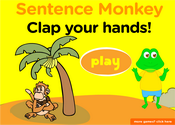Classroom Commands Sentence Monkey Game
- Learning Objectives: Practice using classroom commands and imperatives in this fun English sentence game. Some of the verbs used in classroom commands are phrasal verbs which are always followed by prepositions - stand up, sit down
- How to play: Click play and listen to a sentence. Drag and drop the correct words to fill in the blank spaces below. If you are correct, the monkey gets a banana. Help the monkey get a banana by getting the sentences right!
- Vocabulary: Phrasal verbs, stand up, sit down, turn around, stretch out
- Sentence structure: Clap your hands.
- Educational goal: Create opportunities for student-driven English learning. This game is great for visual, auditory and kinesthetic learners.
The Power of Games in Teaching English Classroom Commands
Games are not just for fun; they are a potent tool for teaching. When it comes to teaching English as a Second Language (ESL) to children, one critical area to focus on is classroom commands. Learning commands in English is essential for effective classroom management and smooth communication between teachers and students. But how do you make this learning engaging? Enter the world of commands games!
The Importance of Classroom Commands in English
Before diving into the game aspect, it’s important to note why classroom commands in English are vital. They help maintain order, promote good behavior, and facilitate learning in a multicultural environment. As a teacher, you don’t want to waste time translating or explaining what “sit down” or “open your books” means. Having a common language through English classroom commands creates a conducive learning environment.
Types of Command Games for Learning
When it comes to commands games, the possibilities are endless. From interactive board games to digital platforms, there's something for everyone. Here are a few types:
- Simon Says: A classic game where students must quickly respond to verbal commands.
- Role-playing: Students take turns acting as the teacher, issuing commands that the class must follow.
- Bingo: Create Bingo cards with different classroom commands that students must recognize and mark when said out loud.
FredisaLearns: A Leader in Command Games
One resource that stands out for its innovation in teaching classroom commands through games is FredisaLearns. Their online platform offers an array of games that not only entertain but also educate. One of their standout games is the Unit 1 Classroom Command Free Game, which uses interactive scenarios to teach common classroom commands.
Explore more English courses and games on FredisaLearns.
Incorporating Commands Game into Your ESL Curriculum
Adding a commands game into your ESL teaching doesn't have to be a complicated process. Here are some quick steps:
- Identify Needs: Know the classroom commands that are most useful for your students.
- Choose the Right Game: Not all games are suitable for all ages or levels.
- Prepare Resources: Whether it's printables for a board game or setting up a digital platform, be ready with all the resources.
- Explain the Rules: Before starting any game, make sure the students understand how to play.
- Review and Reinforce: Use the game to review and reinforce classroom commands periodically.
Benefits of Using Commands Games in ESL Classrooms
- Engagement: Games are fun, which makes children more willing to learn.
- Repetition Without Boredom: Games naturally involve repetition, which is crucial for learning, without being tedious.
- Peer Learning: When children play games in groups, they learn from each other.
- Immediate Feedback: Games offer immediate feedback, enabling students to understand and correct their mistakes instantly.
Challenges and How to Overcome Them
While the concept of using games to teach classroom commands is appealing, it isn't without challenges.
- Distractions: Games can sometimes become too exciting. The key is to keep control without stifling the fun.
- Inclusivity: Not all students may understand the game right away. Always be prepared with simpler versions or alternative activities.
Conclusion: Command Your Classroom with Games
As an ESL educator, your aim is to create an interactive and fruitful learning environment. Classroom commands in English serve as the basic vocabulary that streamlines communication and management in this setting. Commands games are a fantastic tool to achieve this, making learning not only effective but also enjoyable. With resources like FredisaLearns, making command games a part of your ESL curriculum has never been easier.
Teaching commands doesn't have to be a command itself; it can be a game, and a fun one at that!






